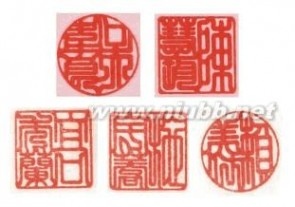一 : preeminent 与 eminent 的区别
p(嫑-犇)reeminent 与 eminent 的区别
pre-eminent——eminent跟prominent的意思非常接近,都是指著名的、重要的、受敬佩的;而pre-eminent(卓越的)则强调比同类更佳、更重要.
二 : Seal与Stamp的区别
Seal 与Stamp的区别
公章是个常用概念,在英语中有不同的表达方式。(www.61k.com)另外,中国的公章作用与西方国家也有所不同。下面尝试对不同用词分别加以说明。
1. Seal
1)含义:Seal是个常见词,既指印纹也指印章本身。它可以指蜡质(wax)的压入图案(impressed figure),也可以指纸上凸起的图案(embossed figure);
2)目的:是证实文件的真实性(authenticating a document)。研究seal的学问叫sigillography或sphragistics。


Embossed figure
3)种类:
A. Seal也可以指产生压入或凸起图案(impression or embossment)的工具
(device),即一种模具(mould),带有与印纹凸凹相反(counter-relief)的镜面图案(mirror image)。这两种图案都可以叫imprint。

corporate seal

Imprint
B .如果是靠压力在纸上产生图案,不需要蜡、印泥或油墨,那么这种seal叫dry seal【汉语的钢印?】。
dry seal
C. Seal印纹可以包括文字(text)或图案(pictorial emblem)。

Text

emblems
stamp Seal与Stamp的区别

pictorial emblem

text and emblem
4)在中国:seal是一种书面身份证明(written identification);即使在现代,它也常替代手写签名(handwritten signature)用以证实一份文件。(www.61k.com]个人和组织(individual and organization)都有正式印章(official seal),还有适合不同场合(situation)的尺寸和风格(size and style)。红色印泥(red oil-based paste)通常含有朱砂(cinnabar)。刻印(seal engraving)是书法艺术(calligraphy)的一种。香港用chop来表示seal或stamp,这在其它英联邦国家属于非正式用法;正式名称通常是rubber stamp。Seal可以统称印章(printing stamp)及其印纹(impression),在个人文件(personal
document)、办公文件(office paperwork)、合同(contract)、艺术(art)及其它需要确认(acknowledgement)或作者(authorship)的场合代替(in lieu of)签名。如今通常做法是签名加印章。在很多西方国家,被授权签字人(authorized signatory)的签字就是效力的最高证据,但在中国,公安机关(PSB)注册的公章的效力超过签名;公章往往就代表公司。

company chop
印章戒指(signet ring)通常是凹刻(intaglio engraving),也是一种seal,往往带有纹章(coat of arms)。

signet ring
Seal of Approval指权威人士或机构(authoritative person or institute)的正式批准或认可(formal approval),不一定是seal的形式或具体标志(marking)。

seal of approval
stamp Seal与Stamp的区别
2. Rubber Stamp:
Rubber stamp通常分三种:办公、装饰和玩具。[www.61k.com]在欧洲,正式文件的签名需要用stamp确认(verify)。丢失的印章可能被用来伪造正式文件(forgery of official document),因此需要小心保管。办公用印章(business rubber stamp)可以是定制的
(custom-made),也可以从文具商(stationer)那儿买现成的(ready-made),通常包含地址(address)、标示(logo)、名称(name)等内容。有时有活动部件(movable part)来调整日期(date)及文字(wording)。有pre-ink(预加油墨)、自动充墨(self-inking)等种类。


rubber stamp with adjustable date

rubber stamp with adjustable date
rubber stamp
Stamp是物体上的一种特殊标记(mark)或印痕(impression),也可以是产生这些标识的工具,甚至可以是贴在物体上的东西(sticker)。所以,邮票(postage stamp)也简称stamp。其它如印花税票(revenue stamp)、配给票(ration stamp)【粮票、布票、肉票等似属于这种】等。注意,集邮作为一种爱好(hobby),准确地表达应该是stamp collecting,而philately指研究邮票和印花税票的学问。

revenue stamp
扩展:seal和stamp的区别 / seal stamp 区别 / seal stamp
三 : all与whole的区别
whole和all的用法及区别:
这两个词意思相近。(www.61k.com]但与限定词和名词连用时,它们的词序各不相同。试比较: “all + 限定词 + 名词”
“限定词 + whole + 名词”
1)all与 whole都可以和单数名词连用。例如:
①Mary spent all the summer at home.
玛丽整个夏天都是在家里度过的。
也可以说成:
②Mary spent the whole summer at home.
③all my life我的一生=my whole life
2)whole与all都可以和单数可数名词连用,但whole更为常见。例如:
④Mary wasted the whole lesson.
(较 all the lesson更常见)玛丽把整整一堂课都浪费掉了。
⑤He ate the whole chicken.
(较…all the chicken更常见)他把整只鸡都吃掉了。
3)all通常与不可数物质名词连用,而 whole则不能。例如:
⑥ 正:Jane has drunk all the milk.
误:Jane has drunk the whole milk.
珍妮喝光了所有的牛奶。
⑦You can easily spend a whole day there.
(whole多与可数名词连用)
你可以轻松地在那里呆上一整天。
▲但有些抽象名词前可用 whole。例如:
⑧Can you tell me the whole truth?(=Can you tell me all the truth?)
你能告诉全部事实真相吗?
4)the whole of或all(of)可放在专有名词,代词和限定词之前。例如:
⑨The whole of/All of London was under water.
整个伦敦都被水淹没。
⑩He has just read the whole of Gone With The Wind.(=…all of Gone With The Wind.)
他刚把《飘》全部看完。
I don't understand the whole of/all of it.
这件事情我并不完全了解。
all与whole的区别
1. 有时这两个词大致同义,只是位置不同:all 要放在冠词、指示代词、物主代词等之前,而 whole 应放在这些词之后
2. 在复数名词前一般用 all,在单数可数名词前一般用 whole。
. 在不可数名词之前一般用 all,而不用 whole (偶尔有例外:the whole time / all the time; his whole energy / all his energy 等),但在物质名词前则绝对不用 whole。
4. 在表地点的专有名词之前,一般用 all 而不用 whole,但可用the whole of。
5. 在时间名词(如day, week, month, year 等)以及季节名词(spring,summer, autumn, winter) 之前,两者都可用(注意冠词的位置)。
简单的说whole=all the
whole all与whole的区别
all day
1)all与 whole都可以和单数名词连用。(www.61k.com)例如:
①Mary spent all the summer at home.
玛丽整个夏天都是在家里度过的。
也可以说成:
②Mary spent the whole summer at home.
③all my life我的一生=my whole life
2)whole与all都可以和单数可数名词连用,但whole更为常见。例如: ④Mary wasted the whole lesson.
(较 all the lesson更常见)玛丽把整整一堂课都浪费掉了。
⑤He ate the whole chicken.
(较…all the chicken更常见)他把整只鸡都吃掉了。
3)all通常与不可数物质名词连用,而 whole则不能。例如:
⑥ 正:Jane has drunk all the milk.
误:Jane has drunk the whole milk.
珍妮喝光了所有的牛奶。
⑦You can easily spend a whole day there.
(whole多与可数名词连用)
你可以轻松地在那里呆上一整天。
▲但有些抽象名词前可用 whole。例如:
⑧Can you tell me the whole truth?(=Can you tell me all the truth?)
你能告诉全部事实真相吗?
All 与whole
all用来修饰由同部分组成的集合体时,all所强调的是构成整体的各个部分,而whole侧重于把事物看成一个整体。由于all与whole在词义上的这种差别,所以下列可数名词只能跟whole搭配:
the whole life/plan/system/scheme/situation/truth/distance
这就是说the whole situation是一个固定搭配。而下列可数名词则常常跟all搭配:
all day/week/month/year/spring/winter/way
all the day:一整天(是确定的某一天)
all days:所有的那些天(是确定的某一段日子)
all day:整天(不确指哪一天)
the all day:应该没有此类表达。除非将all改为whole,和第一个短语一样。 all day不等于all the day。all the day表示特指那一天。。
all day 一整天
all the day 那一整天 。。
本文标题:鼋与鳖的区别-preeminent 与 eminent 的区别61阅读| 精彩专题| 最新文章| 热门文章| 苏ICP备13036349号-1